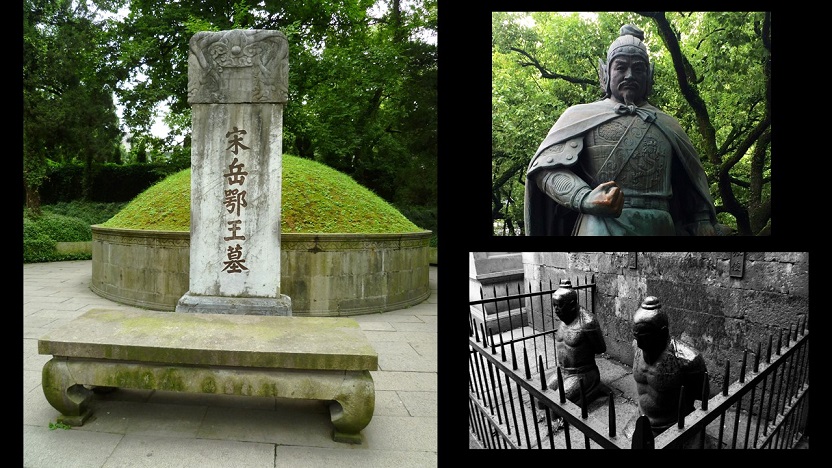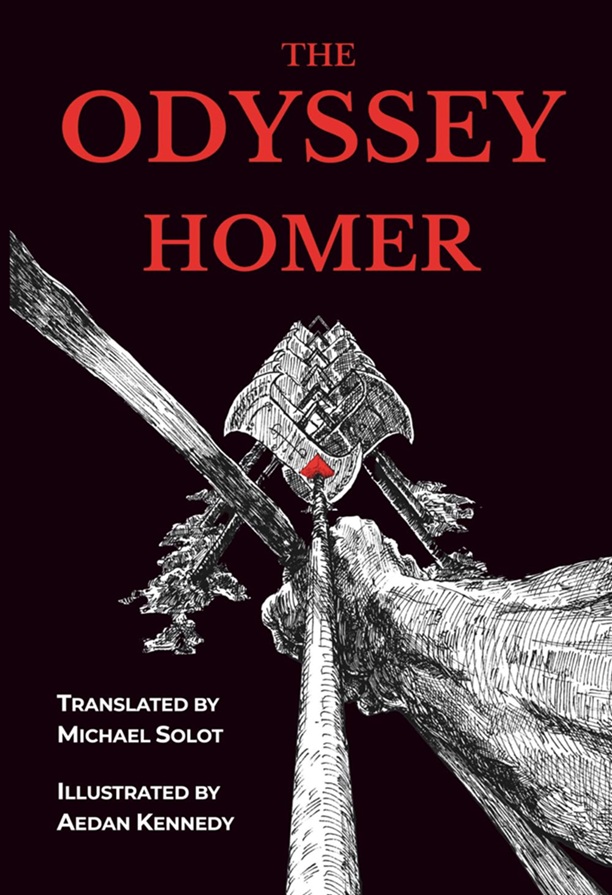.
At the Temple of Yue Fei
Behind, a lake unstirring sleeps;
Ahead, grey fog and budding leaves.
A jade-green pool commands the heart,
Beneath the clouds and sweeping eaves.
A statue beckons; I respond,
And past the present then perceives.
While traitors kneel by mounded tombs,
A land for a martyred hero grieves.
.
Poet’s Note: The Tomb of Yue Fei is a mausoleum for the Southern Song general Yue Fei set in the hills surrounding West Lake in Hangzhou in the People’s Republic of China. Yue Fei was framed and executed for imaginary crimes, and was eventually exonerated and reburied at the orders of the Song Emperor Xiaozong. Near his burial mound are to be found four kneeling figures done in cast iron; they are the traitors held responsible for his death, and it is common for people to spit on them as they walk by. Yue Fei himself is now something of a folk hero with occasional demigod status.
.
.
To a Tea Brick
When I contemplate how you were made—
How your birth was a fluke of your trade
(And how quickly tradition can fade)—
I picture, foremost, the Road.
On a bactrian camel bound West,
Or by porters rough-shod and hard-pressed,
You alight to the end of your quest
In Lhasa’s vaulted abode.
Over mountains I followed your scent,
Which by fortune was bade to ferment,
Till I charted your final descent—
As into my teacup you flowed.
.
Poet’s Note: Beginning in the Tang Dynasty of Imperial China, tea was traded to Tibet in return for horses, creating the famed Tea Horse Road, which wound from Yunnan province through Sichuan to its destination in the Tibetan plateau. The journey there, which took roughly half a year (and oftentimes longer), subjected the tea porters to often-changing weather conditions which dampened the tea, and had the happy effect of causing a bacterial fermentation within the pressed tea cakes. This changed its character a great deal, making it more of a precious commodity over time; this has led, in recent decades, to new techniques which speed up the fermentation process, making pu’er tea more widely available to a broad audience of tea drinkers. Pu’er, like some wines, can be aged for many years. And it still tastes a bit like horse.
.
.
Talbot Hook is a PhD student and occasional writer currently living in Connecticut.















These are beautiful
Thank you.
I enjoyed both of these evocative, history-oriented poems, Talbot. I especially enjoyed “To a Tea Brick” as I happen to be a fan of pu’er tea. It never occurred to me that it tastes “horsey” as I’ve always thought of it as having a musty cave-like taste. Most of the pu’er that is sold comes from China (which we try avoid) but if one is attentive it is possible to get very good pu’er that originates from Japan or Malawi. But I digress. Thank you for two very fine poems!
Dear Brian,
Absolutely. Certain pu’er teas do have that musty cave scent; others are like hay that’s been sitting in a barn for several years, which is where I derive the “horsiness” from. None of that’s meant to be pejorative, of course; one of my favorite pu’ers is called “Camel’s Breath”, after all (which is much lovelier than it sounds)! I’ve never heard of a pu’er created outside of China, but I’ll keep my eyes out!
Thanks for the message, and I’m glad you enjoyed them.
Talbot, I really like “The Temple of Yue Fei” because in these eight lines, you manage to convey a lack of comprehension bursting into perception about the past. In any land, I imagine, memorial sites leave some visitors untouched–even when they know it is a famous place they ought to visit, and have heard why. You set a scene, respond to it as line 5 moves into line 6, then spread the response into a generalization in the last two lines. Nice work.
Mostly anapestic rhythm is a good choice for “To A Tea Brick,” because it gives a horse-riding feel, with a bit of the normal irregular bounce in the last line of each stanza. This makes me wonder if you’ve traveled in China–and whether pu’er tea is sold so insistently by locals in Tibet as Long Jing tea is by Dragon Well locals near Hangzhou.
Dear Margaret,
As always, I appreciate your beautifully-perceptive poetic eye. I fear that you’re right in that many visitors can leave such a location completely untouched. I lived in China (in Hangzhou, actually, where they make the aforementioned Dragon Well tea) for about a year and a half, which is where my love of tea began. I’m not sure if pu’er is pushed so heavily by locals in Yunnan, but I know that in Tibet yak-butter tea is omnipresent.
Thanks so much for the lovely comment.
There’s an exotic feel to these poems, both in the words and the meter.
They’re so much more rewarding, second time round, after reading the notes.
Thanks for the reads.
You’re welcome! I’m heartened to hear that you enjoyed them.
holy moly
I especially responded to “To a Tea Brick”, Talbot, because I drink, morning or afternoon, nothing but China Mutan White. And such a nice nonce form you have created. I’ll have to look into pu’er.
Dear C.B.,
If you like Bai Mudan, you should look into Silver Needle (Baihao Yinzhen — Bai Mudan’s sister white tea using only the topmost bud); it’s a bit softer and more subtle, but you might like it! And, yes, the pu’er world is a great one, so I hope you find something you like. It can be a bit of an acquired taste!
I’ve tried the Silver Needle, Talbot, but I found it so subtle that I couldn’t recognize it as tea. Steeping a greater quantity of leaves did nothing for me but make me realize that I couldn’t afford to drink this on a regular basis. It was sublime, but on a daily basis I need something more grounded.
C.B.,
It is a bit pricey, but I’ve found steeping it for around two minutes at ~165-175 F brings out the flavor well. As always, though, Bai Mudan’s gonna have more bang for its buck. I definitely feel you about the grounding; today (cloudy/rainy) was an Earl Grey/Keemun Hao Ta kind of day . . .
I checked this website (which I hugely respect): https://tea-drunk.com/shop-white-tea/bai-hao-yin-zhen-dian-tou-2020-4snga — and they say to steep it at a much higher temp. for a very short amount of time. Who knows?
– Talbot